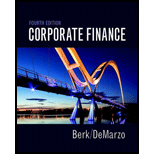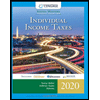
Corporate Finance (4th Edition) (Pearson Series in Finance) - Standalone book
4th Edition
ISBN: 9780134083278
Author: Jonathan Berk, Peter DeMarzo
Publisher: PEARSON
expand_more
expand_more
format_list_bulleted
Question
Chapter 15.4, Problem 1CC
Summary Introduction
To discuss: The personal tax disadvantage of debt for the year 2015.
Introduction:
Personal taxes are similar to corporate taxes that decrease the cash flow to the investor and bring down the firms' value. Interest on income is taxed higher than equity income.
Expert Solution & Answer
Want to see the full answer?
Check out a sample textbook solution
Students have asked these similar questions
Delta Corporation has the following capital structure: Cost Weighted (after-tax) Weights Cost Debt 8.1% 35% 2.84% Preferred stock (Kp) 9.6 5 .48 Common equity (Ke) (retained earnings) 10.1 60 6.06 Weighted average cost of capital (Ka) 9.38% a. If the firm has $18 million in retained earnings, at what size capital structure will the firm run out of retained earnings? b. The 8.1 percent cost of…
Dillon Enterprises has the following capDillon Enterprises has the following capital structure. Debt ........................ 40% Common equity ....... 60 The after-tax cost of debt is 6 percent, and the cost of common equity (in the form of retained earnings) is 13 percent. What is the firm’s weighted average cost of capital? a. An outside consultant has suggested that because debt is cheaper than equity, the firm should switch to a capital structure that is 50 percent debt and 50 percent equity. Under this new and more debt-oriented arrangement, the after-tax cost of debt is 7 percent, and the cost of common equity (in the form of retained earnings) is 15 percent. Recalculate the firm’s weighted average cost of capital. b. Which plan is optimal in terms of minimizing the weighted average cost of capital?
Compute Ke and Kn under the following circumstances:
a. D1= $5, P0=$70, g=8%, F=$7
b. D1=$0.22, P0=$28, g=7%, F=2.50
c. E1 (earnings at the end of period one) = $7, payout ratio equals 40 percent, P0= $30, g=6%, F=$2,20. Note: D1 is the earnings times the payout rate.
d. D0 (dividend at the beginning of the first period) = $6, growth rate for dividends and earnings (g)=7%, P0=$60, F=$3. You will need to calculate D1 (the dividend after the first period).
Chapter 15 Solutions
Corporate Finance (4th Edition) (Pearson Series in Finance) - Standalone book
Ch. 15.1 - With corporate income taxes, explain why a firms...Ch. 15.1 - Prob. 2CCCh. 15.2 - With corporate taxes as the only market...Ch. 15.2 - How does leverage affect a firms weighted average...Ch. 15.3 - How can shareholders benefit from a leveraged...Ch. 15.3 - How does the interest tax shield enter into the...Ch. 15.4 - Prob. 1CCCh. 15.4 - How does this personal tax disadvantage of debt...Ch. 15.5 - How does the growth rate of a firm affect the...Ch. 15.5 - Do firms choose capital structures that fully...
Ch. 15 - Prob. 1PCh. 15 - Grommit Engineering expects to have net income...Ch. 15 - Suppose the corporate tax rate is 40%. Consider a...Ch. 15 - Braxton Enterprises currently has debt outstanding...Ch. 15 - Your firm currently has 100 million in debt...Ch. 15 - Arnell Industries has just issued 10 million in...Ch. 15 - Prob. 7PCh. 15 - Prob. 8PCh. 15 - Safeco Inc. has no debt, and maintains a policy of...Ch. 15 - Rogot Instruments makes fine violins and cellos....Ch. 15 - Rumolt Motors has 30 million shares outstanding...Ch. 15 - Summit Builders has a market debt-equity ratio of...Ch. 15 - NatNah, a builder of acoustic accessories, has no...Ch. 15 - Restex maintains a debt-equity ratio of 0.85, and...Ch. 15 - Acme Storage has a market capitalization of 100...Ch. 15 - Milton Industries expects free cash flow of 5...Ch. 15 - Prob. 17PCh. 15 - Kurz Manufacturing is currently an all-equity firm...Ch. 15 - Rally, Inc., is an all-equity firm with assets...Ch. 15 - Prob. 20PCh. 15 - Facebook, Inc. had no debt on its balance sheet in...Ch. 15 - Markum Enterprises is considering permanently...Ch. 15 - Garnet Corporation is considering issuing...Ch. 15 - Suppose the tax rate on interest income is 35%,...Ch. 15 - With its current leverage, Impi Corporation will...Ch. 15 - Colt Systems will have EBIT this coming year of 15...Ch. 15 - PMF, Inc., is equally likely to have EBIT this...
Knowledge Booster
Similar questions
- Terrier Company is in a 45 percent tax bracket and has a bond outstanding that yields 11 percent to maturity. a. What is Terrier's after-tax cost of debt? b. Assume that the yield on the bond goes down by 1 percentage point, and due to tax reform, the corporate tax falls to 30 percent. What is Terrier's new aftertax cost of debt? c. Has the after-tax cost of debt gone up or down from part a to part b? Explain why.arrow_forwardThe Squeaks Cat Rescue, which is tax-exempt, issued debt last year at 9 percent to help finance a new animal shelter in Rocklin. a. If the rescue borrowed money this year, what would the after-tax cost of debt be, based on its cost last year and the 25 percent increase? b. If the receipts of the rescue were found to be taxable by the IRS (at a rate of 25 percent because of involvement in political activities), what would the after-tax cost of debt be?arrow_forwardNo chatgptPlease don't answer i will give unhelpful all expert giving wrong answer he is giving answer with using incorrect values.arrow_forward
- Please don't answer i will give unhelpful all expert giving wrong answer he is giving answer with incorrect data.arrow_forward4. On August 20, Mr. and Mrs. Cleaver decided to buy a property from Mr. and Mrs. Ward for $105,000. On August 30, Mr. and Mrs. Cleaver obtained a loan commitment from OKAY National Bank for an $84,000 conventional loan at 5 percent for 30 years. The lender informs Mr. and Mrs. Cleaver that a $2,100 loan origination fee will be required to obtain the loan. The loan closing is to take place September 22. In addition, escrow accounts will be required for all prorated property taxes and hazard insurance; however, no mortgage insurance is necessary. The buyer will also pay a full year's premium for hazard insurance to Rock of Gibraltar Insurance Company. A breakdown of expected settlement costs, provided by OKAY National Bank when Mr. and Mrs. Cleaver inspect the uniform settlement statement as required under RESPA on September 21, is as follows: I. Transactions between buyer-borrower and third parties: a. Recording fees--mortgage b. Real estate transfer tax c. Recording fees/document…arrow_forwardHello tutor give correct answerarrow_forward
- Could you help explain, what is the complete salary survey analysis, and ensuring the data is relevant and up-to-date? What is the job evaluation and compensation plan? How to ensure the final report is comprehensive, clearly structured, and aligned with the company vision?arrow_forwardThe maturity value of an $35,000 non-interest-bearing, simple discount 4%, 120-day note is:arrow_forwardCarl Sonntag wanted to compare what proceeds he would receive with a simple interest note versus a simple discount note. Both had the same terms: $18,905 at 10% for 4 years. Use ordinary interest as needed. Calculate the simple interest note proceeds. Calculate the simple discount note proceeds.arrow_forward
arrow_back_ios
SEE MORE QUESTIONS
arrow_forward_ios
Recommended textbooks for you
 Individual Income TaxesAccountingISBN:9780357109731Author:HoffmanPublisher:CENGAGE LEARNING - CONSIGNMENT
Individual Income TaxesAccountingISBN:9780357109731Author:HoffmanPublisher:CENGAGE LEARNING - CONSIGNMENT


Individual Income Taxes
Accounting
ISBN:9780357109731
Author:Hoffman
Publisher:CENGAGE LEARNING - CONSIGNMENT



